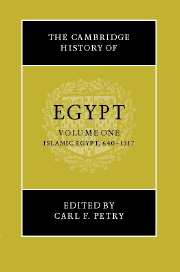Book contents
- Frontmatter
- 1 Egypt under Roman rule: the legacy of ancient Egypt
- 2 Egypt on the eve of the Muslim conquest
- 3 Egypt as a province in the Islamic caliphate, 641–868
- 4 Autonomous Egypt from Ibn Tūlūn to Kāfūr, 868–969
- 5 The Ismā‘īlī Da‘wa and the Fātimid caliphate
- 6 The Fātimid state, 969–1171
- 7 The non-Muslim communities: Christian communities
- 8 The non-Muslim communities: the Jewish community
- 9 The crusader era and the Ayyūbid dynasty
- 10 The Bahrī Mamlūk sultanate, 1250–1390
- 11 The regime of the Circassian Mamlūks
- 12 The monetary history of Egypt, 642–1517
- 13 Art and architecture in the medieval period
- 14 Culture and society during the late Middle Ages
- 15 Historiography of the Ayyūbid and Mamlūk epochs
- 16 Egypt in the world system of the later Middle Ages
- 17 The military institution and innovation in the late Mamlūk period
- 18 The Ottoman occupation
- The Rulers of Egypt, 254–922/868–1517
- Glossary
- Bibliography
- Index
- References
6 - The Fātimid state, 969–1171
Published online by Cambridge University Press: 28 March 2008
- Frontmatter
- 1 Egypt under Roman rule: the legacy of ancient Egypt
- 2 Egypt on the eve of the Muslim conquest
- 3 Egypt as a province in the Islamic caliphate, 641–868
- 4 Autonomous Egypt from Ibn Tūlūn to Kāfūr, 868–969
- 5 The Ismā‘īlī Da‘wa and the Fātimid caliphate
- 6 The Fātimid state, 969–1171
- 7 The non-Muslim communities: Christian communities
- 8 The non-Muslim communities: the Jewish community
- 9 The crusader era and the Ayyūbid dynasty
- 10 The Bahrī Mamlūk sultanate, 1250–1390
- 11 The regime of the Circassian Mamlūks
- 12 The monetary history of Egypt, 642–1517
- 13 Art and architecture in the medieval period
- 14 Culture and society during the late Middle Ages
- 15 Historiography of the Ayyūbid and Mamlūk epochs
- 16 Egypt in the world system of the later Middle Ages
- 17 The military institution and innovation in the late Mamlūk period
- 18 The Ottoman occupation
- The Rulers of Egypt, 254–922/868–1517
- Glossary
- Bibliography
- Index
- References
Summary
Fāṭimid political history
At the heart of the Fātimid state lay the imamate, which challenged both the political hegemony and the religious authority of the Sunnā ‘Abbasid caliphate. The Fātimids were a sect of Shī‘īs, that is, one of several groups who argued that ‘Alī ibn Abī Tālib should have succeeded the Prophet Muhammad as head of the Islamic community of believers. These partisans of ‘Alī (shī‘a, hence the term Shī‘ī) also eventually claimed that the headship of the Islamic community should rest with the descendants of ‘Alī and his wife Fātima, the daughter of the Prophet. They also believed that the descendants of ‘Alī and Fātima had inherited special authority to interpret the Qur‘an and religious law and belief. Disputes among different groups of Shī‘īs often centered, therefore, around genealogy. The Fātimids traced their own descent through Ismā‘īl, one of the early Shī‘ī imams, and thus we call them Ismā‘īlī.
When the Fātimids came to Egypt, they had already worked out their genealogical claims in detail, moved from being a secret missionary group to an openly declared caliphate, and founded a state in Ifriqiyya (modern–day Tunisia). The turning–point for the dynasty came with the accession of the fourth Fātimid imām–caliph, al–Mu‘izz li–dīn Allāh in 342/953. In 358/969, he succeeded in conquering Egypt after three unsuccessful attempts by his predecessors. The relatively bloodless campaign was led by his general Jawhar, who founded a new capital city, Cairo, just two miles north of the original Arab capital Fustāt. Several years later, al–Mu‘izz moved his court from north Africa to Cairo, and Egypt remained the center of the Fātimid empire until the end of the dynasty in 1171.
- Type
- Chapter
- Information
- The Cambridge History of Egypt , pp. 151 - 174Publisher: Cambridge University PressPrint publication year: 1998
References
- 4
- Cited by

